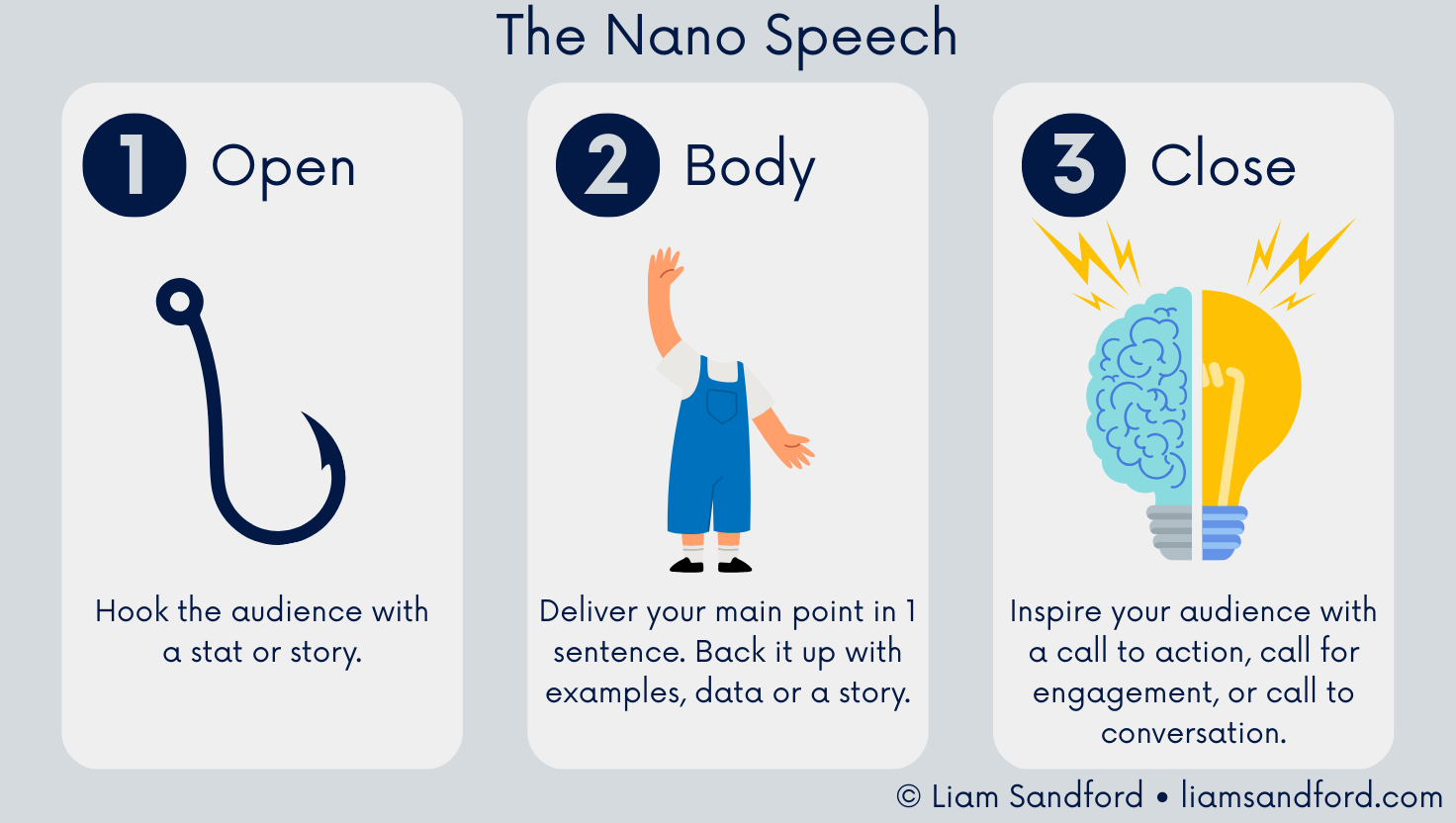Public Speaking Tips: How to Craft an Engaging and Memorable Speech

Liam Sandford
Liam Sandford is a public speaking coach, marketing leader, and 2x Best Selling Author, including the book Effortless Public Speaking. He helps introverted professionals and leaders take control of public speaking anxiety and use speaking to market themselves, build influence, and communicate with impact.
Delivering a speech is not about putting on a performance. It is about designing a deliberate experience that holds your audience’s attention from the first word to the last. Every memorable speech is built with intention, combining structure, clarity, and storytelling to guide listeners through a journey they will remember.
An engaging speech is crafted, not stumbled upon. By building your talk with rhythm, clear transitions, and carefully timed moments of impact, you ensure your message lands and resonates. Treat your speech as a design project—every element should serve the purpose of engaging your audience and leaving a lasting impression.
Why Structure and Rhythm Are Essential in Public Speaking
Structure gives your audience confidence and clarity. Using the Nano Speech framework, which includes Open, Body, and Close, allows you to create a natural rhythm that combines education, entertainment, and reflection.
Your role as a speaker is to maintain this rhythm intentionally. Stories, examples, and data points are tools to keep attention focused when delivering your most important messages. A speech with clear structure and purposeful pacing helps the audience follow your ideas and remain invested throughout.
How to Structure Your Speech for Maximum Impact Using the Nano Speech
A clear structure is essential for audience comprehension and retention. Using the Nano Speech framework, Open, Body, Close, provides a roadmap that keeps both you and your audience on track, no matter the length of your speech.
Open With Impact Without Relying on Humor
The start of your speech sets the tone for everything that follows. Avoid opening with a joke, which can fall flat and distract from your message. Instead, begin with something that immediately demonstrates relevance. This could be a story, a compelling statistic, a question, or a bold statement that signals to your audience that they must pay attention.
The best openings generate curiosity and anticipation. They make your audience lean forward, ready to hear every word. Planning your opening carefully shows respect for your audience’s time and creates a strong foundation for the rest of your speech.
Body: Deliver Your Core Message with Stories and Examples
The body of your speech is where you deliver value. You should be able to deliver your main point in one sentence. The rest of the body is bringing it to life. This helps you stay clear and engaging.
Pay attention to moments when your audience’s Eyes Light Up. These are moments of high engagement created by relatable stories or surprising insights. Including multiple high-engagement moments throughout your speech ensures it is memorable and impactful. Where you see these moments, you can use them again and again in different speeches you deliver.
Close: Leave a Lasting Impression
A strong closing is about intentional impact. Avoid ending with generic phrases like that is all I had. Instead, plan your final words to leave the audience thinking, feeling, or ready to take action.
Your close should answer one question: What do I want the audience to do, believe, or feel next? The end of your speech is not really an ending. It is the start of your audience carrying your message forward. A purposeful close ensures your speech continues to influence and inspire long after you leave the stage.
Keep Your Speech Moving to Maintain Momentum
Momentum Is About Progress, Not Speed
A speech that keeps moving naturally sustains audience energy. Momentum means that every point either introduces something new or builds on previous ideas. Avoid dwelling too long on a single topic. Once you make a point and support it with evidence, examples, or stories, transition smoothly to the next idea.
Plan Effective Transitions Between Sections
Transitions are often where speakers lose their audience. Thoughtful transitions connect sections of your speech and maintain engagement. When each point flows logically to the next, your speech feels deliberate, confident, and easy to follow. Clear transitions keep your audience invested throughout the talk.
Master the Attention Game With Emotion, Momentum, and Action
Attention Is Earned, Not Given
The most effective speakers understand that attention must be earned continuously. You capture attention through clarity, storytelling, and audience-centered content.
There are three pillars to holding attention:
Emotion, by connecting your message to feelings your audience can relate to
Momentum, by keeping the speech progressing without stagnation
Action, by giving listeners clear steps or takeaways
Integrating these elements ensures your audience stays engaged and experiences your speech as a meaningful journey rather than a lecture.
Build Anticipation to Keep Your Audience Hooked
Use Storytelling to Spark Curiosity
Anticipation keeps an audience leaning forward. Stories are the key to creating suspense and curiosity. Every section of your speech should provide a reason for your audience to continue listening.
Ask yourself when planning your speech how you can make listeners eager to hear what comes next. Anticipation also applies to the close, where careful preparation ensures your ending feels impactful and memorable.
Ask for Audience Action at the Optimal Moment
Mid-Speech Requests Maximize Engagement
If you need your audience to take action, the best time to ask is in the middle of your speech. By this point, trust and attention are at their peak.
Many speakers wait until the end to request action, but by then attention has waned and people are distracted. Asking in the middle ensures listeners are attentive, receptive, and more likely to respond. This simple adjustment increases conversions and participation.
Create Eyes Light Up Moments for Deep Audience Connection
Make Your Audience Feel Seen and Understood
The most powerful moments in a speech are when the audience truly connects with your words. These are the Eyes Light Up moments, when listeners nod, smile, or lean forward because your message resonates personally.
These moments happen when your audience recognizes themselves in your stories or examples. They are memorable and encourage people to share your ideas with others, extending the impact of your speech far beyond the stage.
Key Principles for Designing an Engaging Speech
To summarize, an engaging speech is about deliberate design:
Use clear structure and rhythm to guide your audience
Open with impact, not forced humor
Keep your speech moving to maintain momentum
Plan smooth transitions between ideas
Build anticipation to keep listeners engaged
Ask for action at the moment of peak attention
Create Eyes Light Up moments to deepen connection
Close with intent to leave a lasting impression
Following these principles allows you to craft speeches that capture attention, resonate emotionally, and create memorable experiences that inspire action. For more on taking your speeches to the next level, read through the Ultimate Guide to Public Speaking.
TL;DR
An engaging speech is built on structure, emotion, and intentional design, not forced humor or filler.
Open with impact: Start with a story, statistic, question, or bold statement instead of a joke to grab attention and set relevance.
Deliver value in the body: Keep your main point clear, use stories to create Eyes Light Up moments, and maintain flow with smooth transitions.
Close with purpose: End by prompting action, belief, or emotion, never with a flat “that’s all.”
Maintain momentum: Progress steadily, avoid lingering too long, and connect sections logically.
Earn and sustain attention: Use emotion, momentum, and action throughout, asking for audience engagement at peak attention mid speech.
Following these principles ensures your speech connects deeply, sustains energy, and leaves a lasting impression.
More From Liam Sandford
Read my book: Effortless Public Speaking. Learn how to speak confidently, reduce stress, and turn public speaking into your competitive advantage. These actionable public speaking tips will help you improve your presentation skills for any audience.
Join the free 5-day email course: Get daily lessons packed with practical strategies to deliver effective presentations and speak confidently. This course is designed to build your public speaking skills step by step. Sign up below:

